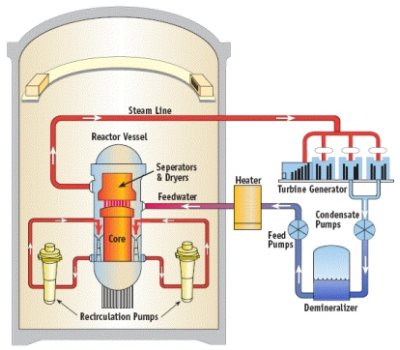(Edwin I.) Hatch Nuclear Power Plant, Georgia
Next Update: August 2009
Hatch Nuclear Power Plant
Net Generation and Capacity, 2007
Unit |
Net Capacity |
Generation |
Capacity |
Type |
On Line |
License |
| 1 | 876 | 7,499.08 | 97.7 | BWR | Dec. 31, 1975 | Aug. 6, 2034 |
| 2 | 883 | 6,749.03 | 87.3 | BWR | Sept. 5, 1979 | Jul. 13, 2038 |
| 1,759 | 14,248.11 | 92.5 | ||||
| *On January 15, 2002, licenses were Renewed. The original license for unit 1 expired in 2014 and for unit 2, in 2018. BWR = Boiling Water Reactor Sources |
||||||
Description: The Edwin I. Hatch nuclear power plant is near Baxley, Appling County, in southeastern Georgia. The plant is located on a 2,244-acre site. In 1994, the plant site was certified as a wildlife habitat by the Wildlife Habitat Council.
Hatch, Unit 1
Nuclear Steam System Supplier (NSSS Vendor) = General ElectricArchitect Engineer = Bechtel
Owner = City of Dalton, 2.2 percent, Georgia Power Company, 50.1 percent, Municipal Electric Authority, 17.7 percent, and the Oglethorpe Power Corp., 30 percent. Operator (Licensee) = Southern Nuclear Operating Company
Hatch, Unit 2
Nuclear Steam System Supplier (NSSS Vendor) = General Electric
Architect Engineer = Bechtel
Owner = City of Dalton, 2.2 percent, Georgia Power Company, 50.1 percent, Municipal Electric Authority, 17.7 percent, and the Oglethorpe Power Corp., 30 percent.
Operator (Licensee) = Southern Nuclear Operating Company
Boiling Water Reactor (BWR)
In a typical commercial boiling water reactor (1) the reactor core creates heat, (2) a steam-water mixture is produced when very pure water (reactor coolant) moves upward through the core absorbing heat, (3) the steam-water mixture leaves the top of the core and enters the two stages of moisture separation where water droplets are removed before the steam is allowed to enter the steam line, (4) the steam line directs the steam to the main turbine causing it to turn the turbine generator, which produces electricity. The unused steam is exhausted to the condenser where it is condensed into water. The resulting water is pumped out of the condenser with a series of pumps, reheated, and pumped back to the reactor vessel. The reactor's core contains fuel assemblies which are cooled by water, which is force-circulated by electrically powered pumps. Emergency cooling water is supplied by other pumps which can be powered by onsite diesel generators. Other safety systems, such as the containment cooling system, also need electric power.
 |
| © U.S. Nuclear Regulatory Commission |
Containment: According to the U.S. Nuclear Regulatory Commission, both units include boiling water (BWR) Mark 1 reactors.
_________________________________________
Sources for Data in Table: Capacity, for purposes of this report, is the net summer capability as reported in Energy Information Administration (EIA) Form EIA-860, "Annual Electric Generator Report." Capacity Factor is a percentage calculation in which the maximum possible generation (based on net summer capability) is divided into the actual generation then multiplied by 100. Generation is the net electricity output reported by plant owners on Form EIA-906, “Power Plant Report.” Type of Unit: All U.S. commercial reactors currently in operation are one of two types: BWR (boiling water reactor) or PWR (pressurized light water reactor). The type, on-line date, and the license expiration date are published annually in Information Digest by the U.S. Nuclear Regulatory Commission.